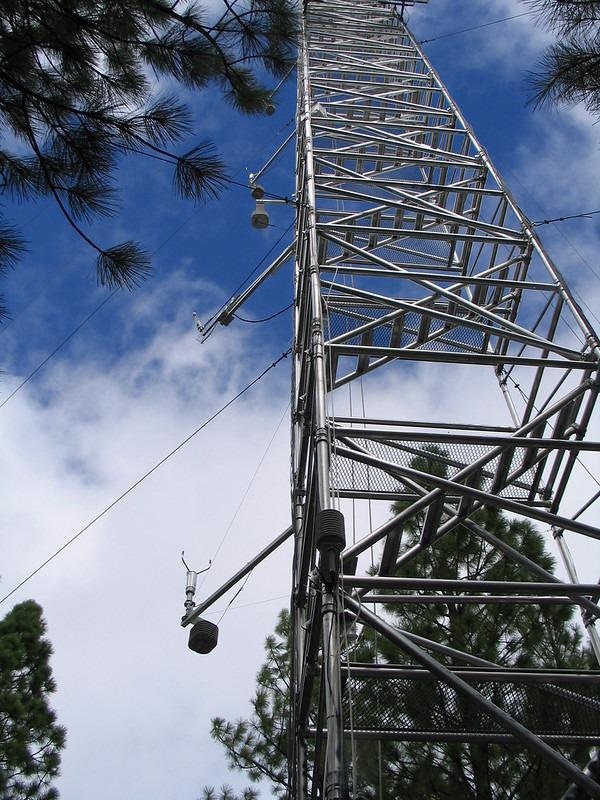An international research group led by Bev Law, a researcher from Oregon State University, uncovers three variables that determine the health of a terrestrial ecosystem. The variables include the ability of the vegetation to uptake carbon and its efficiency to use carbon and water.
 Metolius flux tower. Image Credit: Oregon State University
Metolius flux tower. Image Credit: Oregon State University
The study is significant as the scientists and policymakers require a simple, faster and less expensive method to quantify the way in which the ecosystems that humans depend on respond to climate and environmental changes, also covering the effects caused by people.
The study was published in the journal Nature.
We used these complex, continuous data to develop equations that can be applied with fewer measurements to monitor forest response to climate and other factors.
Bev Law, Professor Emeritus and Researcher, College of Forestry, Oregon State University
The research team led by the Max Planck Institute for Biogeochemistry in Jena, Germany, utilized mathematical models, satellite observations and multiple environmental data streams to quantify the combined action of the three factors to represent more than 70% of total ecosystem function.
On the other hand, a strong carbon uptake, carbon-use efficiency and water-use efficiency imply that at least 70% of all aspects the ecosystem is expected to perform are being performed ideally.
Ecosystems on the Earth’s land surface support multiple functions and services that are critical for society. Those functions and services include biomass production, plants’ efficiency in using sunlight and water, water retention, climate regulation and, ultimately, food security. Monitoring these key indicators allows for describing ecosystem function in a way that summarizes its ability to adapt, survive and thrive as the climate and environment change.
Bev Law, Professor Emeritus and Researcher, College of Forestry, Oregon State University
The efficiency of carbon and water usage is correlated with climate and aridity. This fact pushes scientists to state that climate change will significantly influence the shaping of ecosystem function over the coming years.
The fundamental parts of the current research include data from five semi-arid ponderosa pine sites, where Law has been researching for the past 25 years.
Those sites are in the AmeriFlux network, a set of locations in North, South and Central America, which are managed by principal investigators, like Law, who quantifies ecosystem carbon dioxide, water and energy 'fluxes,' or exchanges within the atmosphere.
AmeriFlux is part of the international FLUXNET project, and data from 203 FLUXNET sites represent a variety of climate zones and vegetation types that were analyzed for the study.
According to Law, who has been involved in forest health research for decades, accounting for the health of an ecosystem has posed challenges for a long time, considering the complexities of ecosystem structure and the way it responds to environmental alterations.
In the 1980s, I was working on the development of indicators including similar carbon-use efficiency, and many of the measurements were incorporated in the Forest Service’s Forest Health Monitoring plots. The new flux paper shows how continuous data can be used to develop algorithms to apply in monitoring forest condition, and for evaluating and improving ecosystem models that are used in estimating the effects of climate on ecosystem carbon uptake and water use.
Bev Law, Professor Emeritus and Researcher, College of Forestry, Oregon State University
The water-usage indicator is a combination of metrics that relate to the water-use efficiency of an ecosystem, which refers to the carbon uptake per amount of water transpired by plants through their leaves. The carbon-use efficiency indicator is a comparison of carbon respired and carbon taken up. Plant respiration implies the conversion of sugar into energy during photosynthesis.
Mirco Migliavacca, the study’s lead author and a researcher at the Max Planck Institute for Biogeochemistry concluded, “Using three major factors, we can explain almost 72% of the variability within ecosystem functions.”
According to Law, the three functional indicators relied greatly on the structure of the vegetation like nitrogen content of leaves, greenness, vegetation height and biomass. This highlights the significance of ecosystem structure, which can be changed by disturbances like fire and also by forest management practices.
Journal Reference:
Migliavacca, M., et al. (2021) The three major axes of terrestrial ecosystem function. Nature. doi.org/10.1038/s41586-021-03939-9.